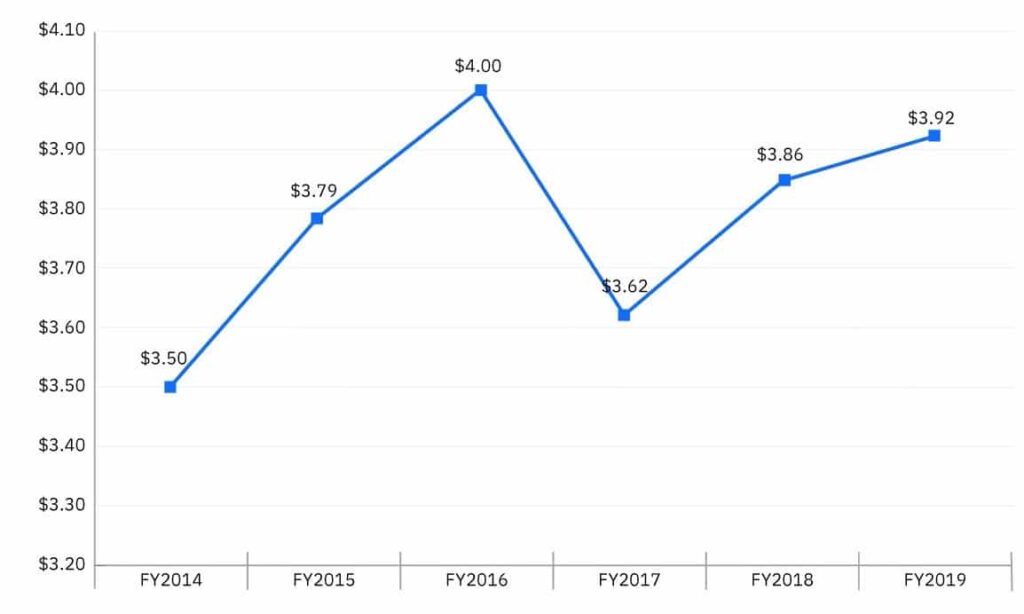How ServiceNow Security Operations Offers Full-stack Security To Your Business
In every organization, security incidents have become common. How we react to address these incidents as quickly as possible is important because the consequences of an attack grow with time. Verizon releases a security breach report every year and according to the report, vulnerabilities are increasing each year despite new security tools in place. These breaches are exposing personal and critical information to businesses and consumers. To help businesses be more proactive and protect themselves against cyber-attacks, ServiceNow comes with a full-stack security operations module.
State of Security Infrastructure Overview
Figure: Average costs of Data breach globally. Source: IBM
Attacks are getting more harmful which means our cybersecurity tools need to become more effective. Organizations can’t keep up with multiple attacks because they aren’t able to scale their tools or grow their teams which leads to attacks going wholly unnoticed. There is also the issue of lack of proper metrics, workflows, and task management which can lead to security threats. With a goal to proactively identifying attacks, they end up creating more noise in terms of alerts, reports, etc.
Tools like SIEM, Endpoint technology, firewalls, and vulnerability scanners, generate reports that need additional correlation. These tools don’t integrate well with each other because they don’t operate in the same way. Each tool requires different pieces of training and expertise to manage. These reports must be manually interpreted and only give a one-dimensional view of the potential problem while excluding any context about your infrastructure.
How ServiceNow Security Operations Can Help Businesses
ServiceNow Security Operations is a security orchestration, automation and response engine built on the Now Platform. Automation along with orchestration can provide an enormous benefit by making the SecOps teams more efficient and able to respond quickly to alerts and large volumes of security incidents.
Three main areas of ServiceNow Security Operations (SecOps) can handle these security threats. The ServiceNow SecOps module works as a triage to address the threats in line with ITIL process. The ServiceNow security operations stack comprises of:
- Security Incident Response
- Threat intelligence
- Vulnerability Management
Security Incident Response
This is the area where all security risks are tracked, which is sourced from various tools. Alerts are fed to the SIEM platform through event sensors, state sensors, and so on. There are other tools that also feed information to the SIEM platform depending on how you configure your infrastructure. ServiceNow has a lot of integrations for automation of threat intelligence, vulnerability and patching information to avoid manual interventions. Without ServiceNow, it can be a nightmare for analysts to manually correlate and see the whole picture of applications and services impacted. ServiceNow lists out the information automatically, thereby reducing human efforts and time.
ServiceNow Security Operations is a scoped application model meaning that you can engage other teams by providing secured access only to the information you wish to share with them. One can instantly engage with the appropriate team for the relevant actions.
Matured ServiceNow workflow processes can be automated and drive a diverse workflow based on the classification of assets and applications. The automation capabilities can be leveraged to correlate other data stores and other log stores. With automated workflows, several tasks are already completed by the time an incident is created and the team starts working on it.
Threat Intelligence
Cyber Threat Intelligence is a vital part of security operations. ServiceNow acts as an ingestion point for any threat intelligence. This includes taxi feeds, commercial feeds from secure works and open source feeds coming into your inbound network. Recurrently the security team verifies the URLs to check for any malicious activity using some tools manually.
With the workflows incorporated using ServiceNow, all these activities are automated. It correlates automatically within the history of incidents and leverages with the endpoints processes or PAP (Password Authentication Protocol), checking for network connections. It correlates with the threat intelligence to find out any feeds used. It can also check on malicious emails received by users in an organization and leverage that information to identify threats.
Vulnerability Management
The very purpose of ServiceNow vulnerability management is to help organizations understand the most common and severe threats from external sources. When news broke on two major security catastrophic issues like Meltdown and Spectre in 2018, experts couldn’t identify the level of risk exposure and they couldn’t decide where to apply the solution first. The majority of breaches are due to existing vulnerabilities.
The ServiceNow platform can be designed so that a vulnerability scan data is automatically imported into the Security Operations Vulnerability Response application using APIs. These reports are matched against the ServiceNow Configuration Management Database. The resulting vulnerable items are assigned a risk score based on multiple factors, including the severity of the vulnerability, and the importance of the affected asset. The risk score is configurable and provides quick prioritization.
Information about the vulnerability, what it is and how to remediate it and the threat is understood and automatically pulled into vulnerability response from the National Vulnerability Database (NVD), eliminating the need for manual research. The customizable dashboards can show the organization’s overall vulnerability exposure, workflows, automation, and orchestration speed up analysis, containment, and eradication.
Now all organizations must be is conscious enough to implement a vulnerability management program to protect them from breaches.













